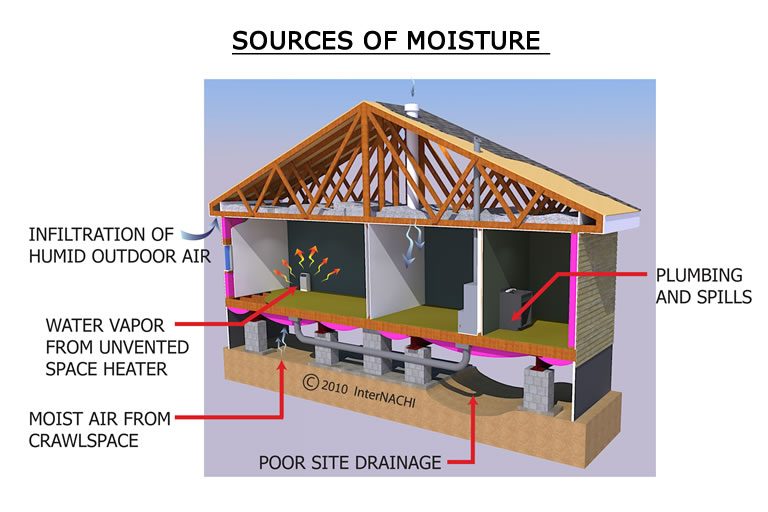Mold and What to Do About It
The Basics of Mold Control in the Home
- Control Moisture
- Fix water problems
- Dry any water damages areas. Mold can start growing again in 24 hours.
Mold serves an essential role in nature by breaking down dead organic matter like leaves, limbs and trees. Indoors it can be a huge problem. Mold reproduces by means of tiny spores, invisible to the naked eye, that float through the air and begin growing when they land on wet surfaces.
Can mold damage your health?
Molds may cause health problems once they take root and begin to grow. They produce allergens and occasionally mycotoxins which can cause severe reactions in some people. Sensitive individuals may exhibit hay fever type symptoms or even asthma attacks if an individual is allergic to mold. Exposure can be irritating to the eyes, nose, throat and lungs even in people who are not allergic. Molds produce allergens (substances that can cause allergic reactions), irritants and, in some cases, potentially toxic substances (mycotoxins).
How can I get rid of mold?
The short answer is no. Mold spores will always be found floating through the air and collecting in household dust, but they cannot grow if there is no moisture present. Control moisture and you’ll control mold. If it begins to grow, fix the water issue and clean up the mold or you will be facing the same problem again.
Can I clean it up myself?
In most cases you can clean it up yourself. If the area is 10 square feet or less you can probably handle the work. Over that and you should probably call an InterNACHI Certified Inspector and consult with them. If you and the inspector agree that you’ll need a contractor make certain that they have experience with mold remediation, check their references and ask them to follow EPA recommendation or other guidelines from professional or governmental organizations like the ACGIH.
If the water/mold damage involves sewage make sure the professional has experience in contaminated water situations, and do not run your HVAC if you suspect it is contaminated with mold. That can quickly spread it throughout your home.
If you feel the mold situation has damaged your health, consult with a health professional prior to cleanup.
How to clean up your mold problem
Note: You may not be able to restore the original appearance of an area or item. Mold can cause severe staining and cosmetic damage. In addition, professional mold remediation professionals can use methods not included in this section.
- Fix any plumbing or other leaks as quickly as you can and dry the areas completely.
- Use a scrub brush, detergent and water to scrub the mold off of hard surfaces.
- Throw away carpet or absorbent/porous materials like ceiling tiles. It can be impossible to remove it completely from these materials.
- Avoid breathing the mold and avoid unnecessary exposure. N-95 respirators can filter out the irritants when fitted correctly, and you should wear long rubber/neoprene gloves and googles without ventilation holes.
- Make sure areas are dry and clean before caulking or painting. Painting over mold will cause peeling.
How do I know when the remediation or cleanup is finished?
Fix any plumbing or other leaks as quickly as you can and dry the areas completely. There should be no visible mold or odors. (Mold may cause staining and cosmetic damage.) You should not have any health complaints or physical symptoms after clean up. If there is any question ask your InterNACHI Inspector.
Moisture and Mold Prevention
Prevent moisture and you prevent mold. Clean up spilled water or damp materials within 24 hours.
Clean roof gutters and make sure they do not leak, and make sure water does not collect around your foundation.
Your HVAC drip pan needs to be clean and drain lines free-flowing. Indoor humidity below 60% is important with a target of below 50%. Condensation is a sign of humidity. If you see it on surfaces, wipe the surfaces and dehumidify the area.
Testing for Mold
Usually, if visible mold growth is present, sampling is unnecessary. There are no EPA limits on mold or mold spores. A surface sample can be helpful when determining if an area has been properly remediated, and sampling should be conducted by professionals with experience in sampling and interpreting results.
Hidden Mold
Mold may be hidden on the backside of dry wall, wallpaper or paneling, above ceiling tiles, or the underside of carpets and pads. Inside walls around pipes (with leaking or condensing pipes) are a common area for mold along with ductwork and in ceiling above ceiling tiles. If an area smells moldy, chances are high there is mold present somewhere
Investigating Hidden Mold Problems
A professional is definitely required, as access can be challenging and disturbing an area could cause a huge release of spores from a porous material.

